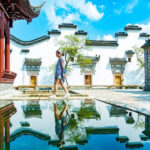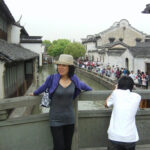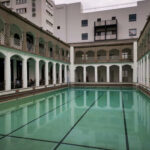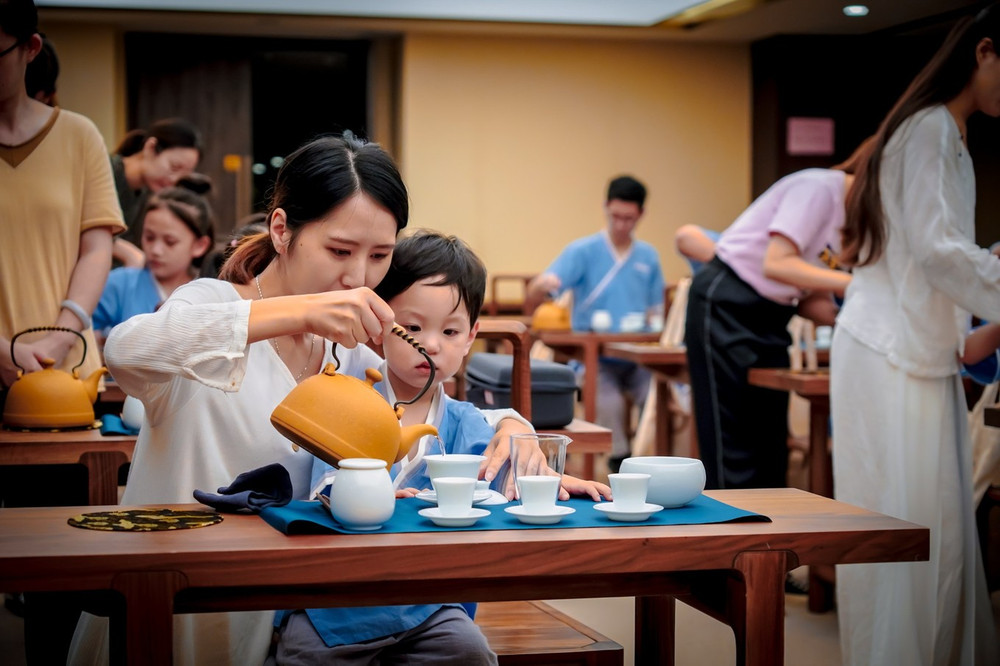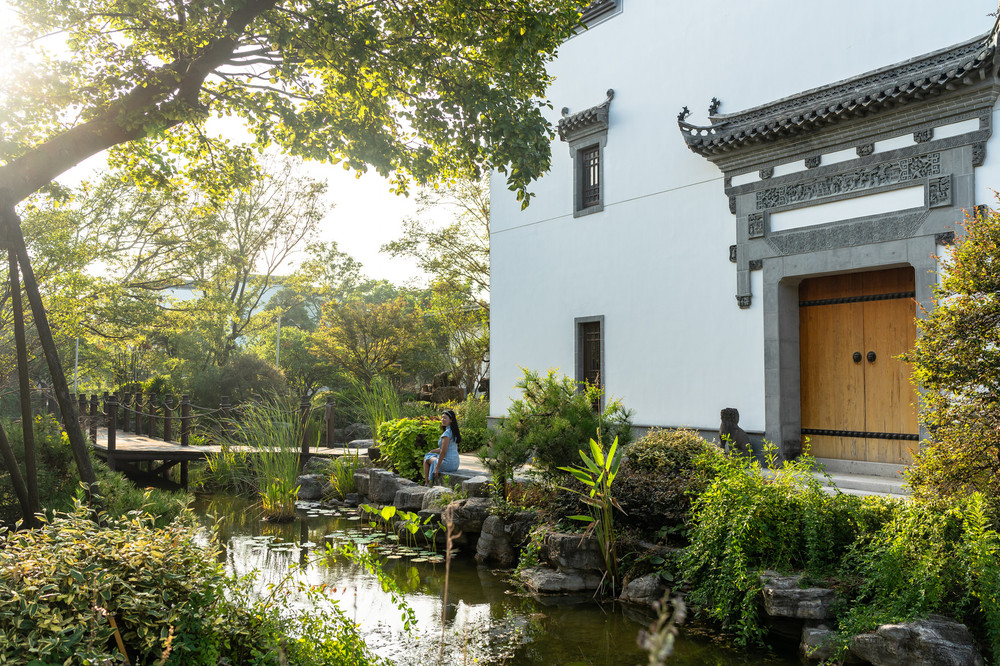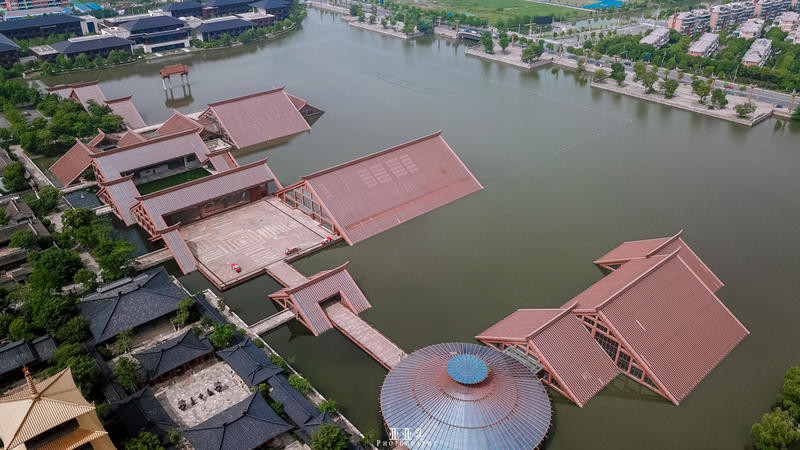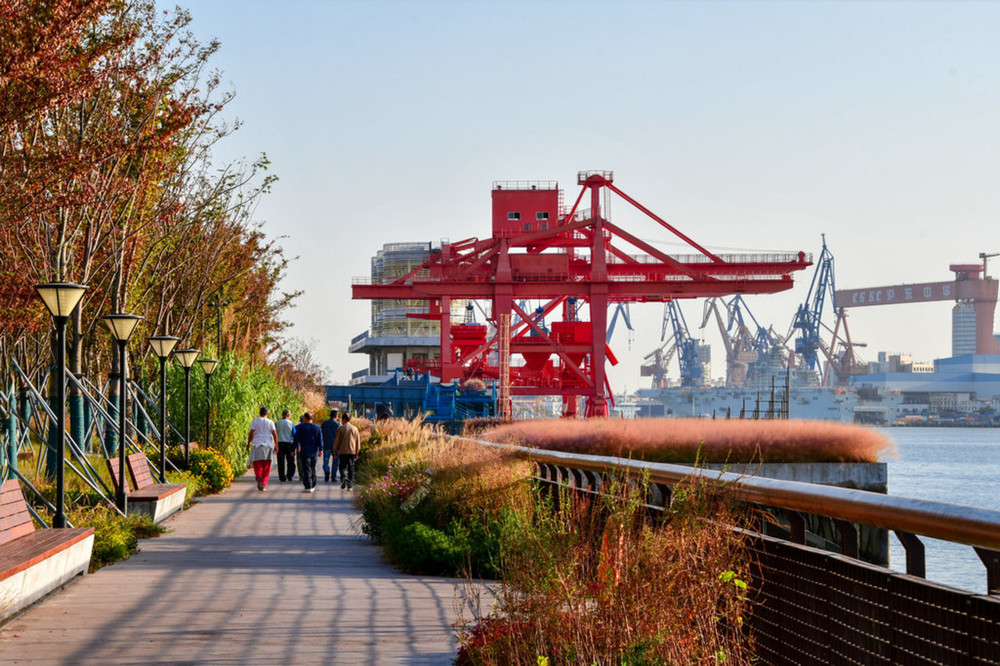**The May Thirtieth Movement Monument: A Starting Point**
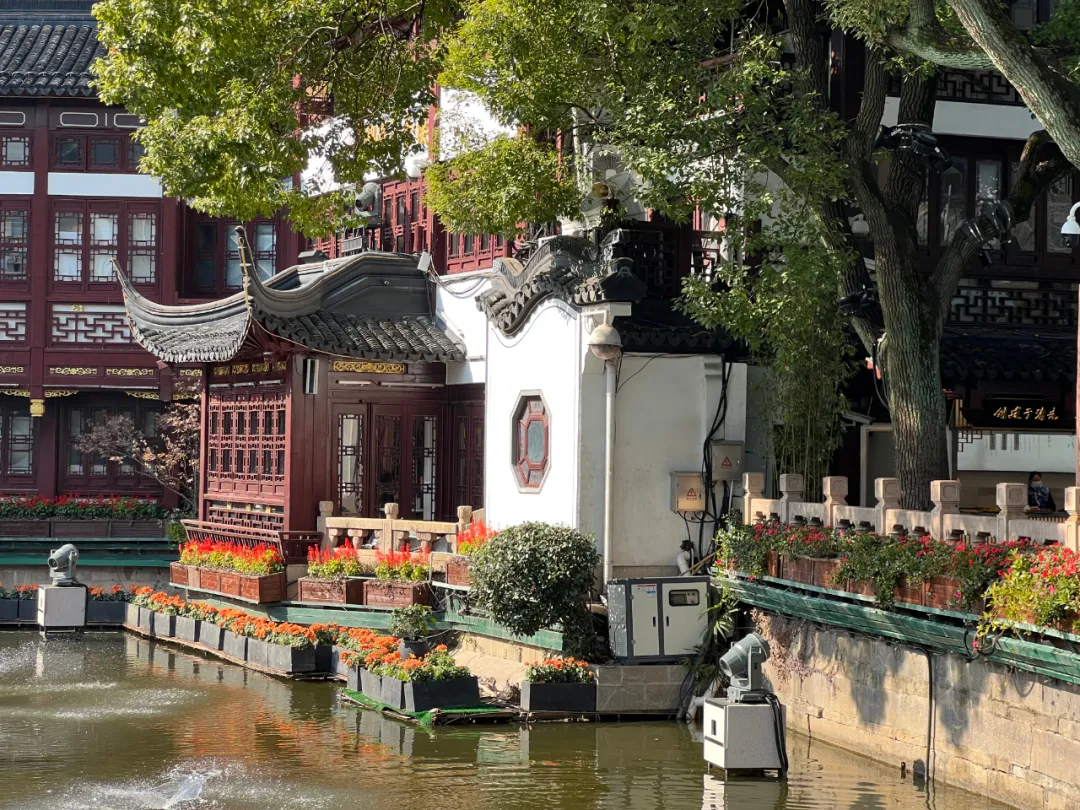
Begin your journey at the May Thirtieth Movement Monument, situated opposite the bustling New World Mall. Here, you’ll easily spot the vibrant Spring and Autumn red pavilion.
**Boarding the Architecture Reading Special Line**
Directly in front of the pavilion, you’ll find the blue double-decker bus that serves as the Architecture Reading Special Line. Upon boarding, exchange your on-site ticket for a convenient blue electronic card. The first row of seats on the second floor is highly sought after for its prime viewing experience. Although we initially missed out on these coveted seats, we found that sitting at the back also provided an excellent vantage point. For those susceptible to motion sickness, the first floor is recommended due to the natural sway of the second floor under the influence of gravity.
**Interactive Mini-Program for Historical Insights**
Each seat back is equipped with a mini-program code. Scanning this code grants access to explanations of historical buildings around each stop and the overall route. Additionally, it features a vehicle positioning function that displays the bus’s current geographical location. This tool is particularly useful if you find yourself away from a stop or seeking a meal; simply open the mini-program to check the next bus’s position and arrival time, ensuring you can board promptly.
**Audio Experience and Comfort Considerations**
A minor inconvenience is the lack of provided headphones and the use of a round back jack. You can, however, scan the code and listen to the audio on your phone. The season in Shanghai is comfortably mild, with daytime temperatures remaining warm under the sun’s rays, and the plane tree leaves still clinging to their branches.
**A Scenic Ride Through Shanghai’s History**
The bus traverses Jiujiang Road, Henan Middle Road, and Beijing East Road, offering unique views such as the Sha Mei Building, where internet celebrities often pose for photos on the terrace—a sight best appreciated from the second floor. The second stop marks the beginning of today’s City Walk at the Bund, a place I hold in high regard, especially for strolling along Zhongshan East First Road when it’s less crowded.
**Exploring the Bund’s Historical Significance**
We continued to the Waibaidu Bridge, where we delved into the history of ‘separation of Chinese and foreigners, autonomous concessions.’ A map is a valuable tool for understanding the distribution of these concessions. The Roosevelt Mansion, once the entrance before the British demarcated the British Concession, is already adorned for Christmas. Why is there a Buddha head sculpture in the Bund’s architectural complex? Listen to the explanation to find out!
**The Origins of the Bund**
The original county town of Shanghai was in the Yu Garden area, with most of the east gate of Huangpu River being a natural beach, a popular spot for outings and beach activities. The Huangpu River and Suzhou River were the main rivers at the time. Over centuries, trackers created a winding path along the river beach, known as the ‘track path,’ which later became the earliest road of the Bund. The British, proponents of ocean civilization, recognized the potential of this river and demarcated the riverfront area of the Bund as the ‘anchoring area’ for their ships, leading to the establishment of the British Concession.
**The Bund Architectural Complex: A Testament to History**
The former British Consulate at 33 The Bund is the oldest building in the Bund architectural complex in Shanghai. Reading architecture is akin to reading the history behind it. This two-story colonial-style building was the site of discussions on trade and commerce, marking the beginning of Shanghai’s history of opening to foreign trade.
**The Astor House Hotel and Broadway Mansions**
The Astor House Hotel, located behind the Waibaidu Bridge, was a result of Shanghai’s opening. British businessman Astor Houfoff built a hotel named after himself, which was one of the most modern luxury hotels in the Far East at the time, boasting the first use of gas, electric lights, running water, and elevators, as well as 24-hour hot water. The current Shanghai Hotel, originally known as ‘Broadway Mansions,’ features classic Art Deco style and was once the second-tallest building in Shanghai after the International Hotel. It was formerly the Shanghai British Tram Company and later became a foreign-related hotel where guests can still stay. A search on Ctrip reveals affordable rates, allowing one to experience a stay for just over 600 yuan, fulfilling the guide’s unfulfilled wish to stay at the Astor House Hotel.
**The Jinling East Road Dock: A Quieter Part of the Bund**
This route includes two stops on the Bund, the other being the Jinling East Road Dock. Upon disembarking, the guide awaits at the stop. This quieter part of the Bund area, originally part of the French Concession, leads further into the Shiliupu district.**Shanghai City Walk: Exploring the Charms of Old and New**
The guide immediately posed a question: “Is the British Concession better, or the French Concession better?” He did not beat around the bush: “Old Shanghai people would say that the good place is under the plane trees.” Thinking about it, the Bund was originally a river beach. Here is a map: across the Yangjingbang River (now filled in), next to the British Concession is the French Concession. Adjacent to the boundary of the concessions, the French built the Bund Meteorological Signal Station. Crossing the road, we began this stop’s City Walk.
The guide pointed to the Bund Meteorological Signal Station from a distance and told us that the French Catholic Church’s observatory in Xujiahui relied on this to transmit meteorological information, providing meteorological services for the naval fleets of Western countries. At the same time, this is also one of the only two Atanub-style buildings left in the world, designed by Spanish architect Atanub, mainly in Rococo style. In the 1993 Bund renovation, this building was moved 20 meters to the east as a whole, which was quite challenging at the time.
The Jinling East Road that we passed by was originally called ‘French Da Road,’ and it was the first road in Shanghai to have electric lights. When the lights were turned on, citizens all came to watch. “The buildings on this side of the sidewalk are very special; they are the unique arcade buildings found only in the south, and you won’t get wet walking all the way. You can go and look for them; the furthest north in China where you can find arcades is Shanghai.” A side note: Shanghai also has a British Da Road; guess which one it is?
Tips: This stop has the Jinling East Road Dock, where you can take a ferry to Lujiazui. There are also public toilets by the Bund, a ‘price increased’ Circle K convenience store, and Jay Chou’s Magic Seat milk tea, convenient for everyone to buy water.
**Journey Through Time**
The author visited the following places: Shanghai’s Waibaidu Bridge, Yu Garden, City God Temple, Oriental Pearl Tower, the Bund, Lujiazui, People’s Square, Beijing East Road, Roosevelt Mansion, Huangpu River, Suzhou Creek, the former British Consulate, Peace Hotel, and Jiuqu Bridge. Published on December 9, 2021, at 15:28.
Loving a city begins with understanding it. Every time we talk about ‘traveling like a local,’ City Walk is inevitably a topic of discussion. The concept of City Walk originated in London, UK, and when translated into Chinese, it simply means ‘urban walking,’ which is the act of experiencing and perceiving one’s city through walking. We walk around the city casually, whether it’s a familiar main street, an unfamiliar alley, or a road we’ve walked down countless times without ever paying attention.
Shanghai has many well-known walking routes, and I’ve covered many of those in the French Concession. Each City Walk always allows me to discover new joys and understand my hometown a bit more. Last weekend, my friend Karen and I participated in a City Walk combined with a sightseeing bus tour. We found it on the Shanghai Release, a collaboration between Spring and Autumn Travel and the Shanghai Cultural and Tourism Bureau, known as the ‘Little Blue’ for its architectural reading special line.
To start with the conclusion: before the trip, we joked about whether we would be ‘expelled from our Shanghai citizenship’; after the trip, we exclaimed ‘it was truly delightful!’ The remaining cultural relics and historical sites witness the rise and fall of the city, a teahouse on the corner might have a significant history, and behind a certain building could be the joys and sorrows of ordinary people. These silent buildings, with a perspective that transcends time and space, tell stories one by one. As Gogol said, ‘When music and legends are silent, only architecture still speaks.’
After a personal experience, the 45 yuan trip lasts approximately 5 hours. The route covers both sides of the Pu River, spanning 22 kilometers, with five stops including the May Thirtieth Movement Monument Station, Waibaidu Bridge Station, Jinling East Road Dock Station, Yu Garden City God Temple Station, and Oriental Pearl Tower Station. This trip is suitable for local travel enthusiasts and family outings, especially since we can’t go out recently.
At first glance, these stops may not seem very interesting, but after going around once, you will learn a lot of unique stories from Shanghai, from Yu Garden to the Bund, and then to Lujiazui, which is almost the first half of Shanghai’s history.
**The Mode of Play**
The mode of play is as follows: board the bus in front of the May Thirtieth Monument at People’s Square (opposite the New World Mall), with a dedicated tour guide at each stop, leading everyone to walk and visit, explaining for 30 minutes at each stop, and reserving 15 minutes of free time. Then you can take the next special bus at the station and head to the next stop. The first bus departs at 9:30 and the last bus is at 21:00. Buses run every 45-55 minutes. Before 16:00 in the afternoon, there are tour guides at each stop to provide explanations.### Experience Report: A Day on the Blue Bus Tour in Shanghai
**Freedom to Hop On and Off**
You can get on and off at any stop. In the meantime, you can calculate your own time to have a meal, so there is no need to worry about being hungry due to a long journey. Let’s take a closer look at the experience at each stop.
**Impressive Tour Guides**
What impressed me the most is the tour guides on this bus route. Regardless of gender, they all have extremely extensive knowledge. I would rather call them ‘leaders’. When encountering equally knowledgeable guests and listening to everyone’s discussions is truly a pleasure.
**Encounter with Director Wang at Yu Garden**
At the Yu Garden stop, we met Director Wang. His hair is grayish-white. He has been in the industry for 20 years and constantly quotes various books to introduce Shanghai’s history. When we were waiting for the bus by the roadside, we chatted from the 700 years of ‘Shanghai County Annals’ to Yang Jiang’s life. If there is a chance, I really want to keep chatting with him.
**Rethinking Group Tours**
At the moment the bus arrived, I suddenly realized that in the past, I always thought that ‘group tours’ were not fun. It was because I had never met a leader like Director Wang. He talks eloquently, and his words are full of love for his profession and the city of Shanghai. He is definitely not the kind of tour guide we have in mind who only introduces scenic spots.
**Seeing History Through Architecture**
We often say that ‘to see a hundred years of history, look at Shanghai’. Following his train of thought to look at the buildings, we hear vivid stories. This is an experience that I cannot get by looking up information and reading history books on my own.
**Value for Money**
This blue bus can be enjoyed leisurely for a whole day and is even worth multiple rides. I have even thought about it. The next time my friends from other places come to Shanghai, I will definitely take them on this route. Here is my experience report. For just 45 yuan, you can get a whole day of happiness!
**Recommendations for Eating and Strolling**
In addition to sharing my experience, I will also intersperse recommendations for eating and strolling at each stop. Let’s start from the starting point.
**Starting Point: May 30th Movement Monument**
The starting point is the May 30th Movement Monument, opposite the New World Shopping Mall. It is very easy to find the small red pavilion of Spring and Autumn. The blue double-decker bus in front of us is the special line for reading architecture that I will take. Exchange tickets on site and obtain a blue electronic card.
**Seating and Scenic Views**
After boarding the bus, the seats in the first row on the second floor are the most popular. We didn’t get a seat in the first round and had to sit in the back row. The view is also good. If you are prone to motion sickness, it is still recommended to sit on the first floor.
**Interactive Features**
There is a small program code on the back of each seat. By scanning it, you can see the explanations of historical buildings near each stop and the overall route. There is also a vehicle positioning function, which allows you to see the current geographical location of the bus. If you walk too far from the stop or want to have a meal, you can open the small program to see the location and time of the next bus and get on the bus in time. It is very convenient.
**Tips on Audio Experience**
However, it lacks the provision of headphones, and the rear jack is round. You can scan the code and listen to it on your phone.
**Seasonal Comfort in Shanghai**
This season in Shanghai is very comfortable. During the day when the sun is out, it’s not cold at all. The sycamore leaves haven’t fallen completely yet.
**Views from the Second Floor**
The bus drives from Jiujiang Road, Henan Middle Road, to Beijing East Road, passing by the Sammi Building, where you can see internet celebrities taking photos on the terrace. This is a view that can only be discovered from the second floor.
**The Bund: Starting Point for City Walk**
The second stop is the Bund, officially starting today’s City Walk. The Bund is a place I really like. I also enjoy walking along Zhongshan East First Road, especially when there are few people. We walked to the Waibaidu Bridge and started listening from the history of ‘separation of Chinese and foreign, concession self-governance.’
**Historical Insights**
A map helps to better understand the distribution of the concession areas at that time. The Roosevelt Mansion at the entrance of the British Concession has already been decorated for Christmas. Why does the Buddha head sculpture appear in the Bund building complex? Come and listen to the explanation!
**Shanghai’s Original County Town**
The original county town of Shanghai was in the area of Yu Garden now. Most of the east gate Huangpu River bank was natural beach. People used to come here for outings and play on the beach. The Huangpu River and Suzhou River were the main rivers for hundreds of years. The trackers stepped out a winding path along the river beach, which people called ‘fiber road.’ This fiber road is the earliest road of the Bund.
**The British Concession**
The British, who advocate ocean civilization, saw the importance of this river and river. Before opening a concession in Shanghai, they first designated the river surface of the Bund area as the ‘anchorage area’ for their ships, which later became the British Concession. The former British Consulate at No.**33 the Bund: A Historical Landmark in Shanghai**
The Bund, a symbol of Shanghai’s rich history, is home to the oldest building in its complex: 33 the Bund. This two-story colonial-style building was once the site where the British discussed trade and commerce, marking the beginning of a new era for Shanghai. Reading architecture is akin to reading the history behind it.
**The Astor House: A Luxurious Legacy**
Behind the Waibaidu Bridge stands the Astor House, built as a result of Shanghai’s opening to trade. British businessman Astor House capitalized on the area’s strategic location and constructed a hotel bearing his name. This was one of the most modern and luxurious hotels in the Far East at the time, boasting early use of gas, electric lights, running water, elevators, and 24-hour hot water. Celebrities from around the world were drawn to this prestigious establishment. A tour guide lamented the missed opportunity to stay here, noting that it has since been transformed into a Securities Museum. The lesson? Seize the moment if you wish to experience history firsthand.
**The Shanghai Building: A Testament to Art Deco**
Before you stands the Shanghai Building, originally known as the ‘Broadway Building.’ This classic Art Deco structure was once the second-highest building in Shanghai, only surpassed by the International Hotel. It has housed the Shanghai Tramway Company and later served as a hotel for foreign guests, remaining operational to this day. A stay here, as suggested by a guide, is quite affordable, with rooms starting at just over 600 yuan, offering a chance to step back in time.
**Exploring the Bund: A Journey Through Time**
The Bund’s route includes two stops, the other being the Jinling East Road Dock. Here, the guide poses a question: ‘Is the British Concession better, or the French Concession?’ The answer, according to old Shanghainese, is that the best places are under the plane trees. The Bund, once a river beach, sits between the British and French Concessions. The French built the Bund Meteorological Signal Station along this boundary, which transmitted meteorological information to the French Catholic Church’s observatory in Xujiahui, providing weather services for Western naval fleets. This Atanub-style building, one of the last two in the world, was designed by Spanish architect Atanub in the Rococo style and was moved 20 meters east during the Bund’s 1993 renovation.
**Jinling East Road: A Beacon of Progress**
Jinling East Road, formerly ‘French Da Road,’ was the first in Shanghai to have electric streetlights, drawing crowds when they were first lit. The buildings along this road feature typical southern arcade architecture, ensuring a dry walk even in the rain. Shanghai boasts the northernmost arcades in China. A side note: there is also a British Da Road in Shanghai; can you guess which one it is?
**Conveniences Along the Bund**
At the Jinling East Road Dock, you can take a ferry to Lujiazui. Public restrooms, a Circle K convenience store, and Jay Chou’s Magic Seat milk tea shop are also available, making it a convenient stop for refreshments and rest.
**Shanghai 2.0: A Story of Two Stops**
These two Bund stops tell the story of Shanghai 2.0. For the old flavor of Shanghai, one must visit the Yu Garden area, the earliest county town and the root of Shanghai, where the city’s first banks, silver shops, taverns, teahouses, theaters, and commercial firms were located. Both the British and French Concessions were built outside of this area, partly due to the locals’ discomfort with foreigners at the time.
**Shanghai’s River-Filled Past**
Shanghai was once a city filled with rivers; any road name containing ‘Bang’ or ‘Pu’ signifies a former river. The City God Temple, built during the Yongle era, predates the construction of the Forbidden City in Beijing by two years.The City God Temple is like the Mazu Temple for Fujian people. It is a place where old Shanghai residents always come to pay their respects during festivals. In their leisure time, Chinese people enjoy drinking tea. Not far away is the Congratulatory Spring Pavilion, which was the best teahouse in the old Shanghai county and is named after the phrase ‘the spring breeze is favorable and the horse’s hooves are swift.’
‘What did people like to do in the past?’ ‘Drink tea, stroll in gardens, and listen to storytelling.’ ‘You young lady seem to know a lot!’ So we began to stroll in the gardens. Upon reaching the Ninghui Pavilion, the guide asked me which was the tallest building here. I casually pointed towards the distant Shanghai Tower. The guide laughed at my joke. ‘You are quite humorous; let’s discuss the architecture within the Yu Garden.’ It must be the Ninghui Pavilion, named so because it is perfectly positioned to welcome the first rays of sunlight from the east. It is quite tall indeed.
Walking towards the Jiuqu Bridge and the lakeside pavilion, the Green Wave Gallery is a restaurant we all ate at as children. It is part of Yu Garden and was built during the Jiajing era of the Ming Dynasty. The guide took out his phone to show us many historical photos of this building, including the reception of Queen Elizabeth II. This stop at Yu Garden is suitable for everyone to take a break and have lunch.
While strolling around Yu Garden, I noticed it has changed significantly from the past. With a well-executed national trend, each shop almost sells unique items. Adjacent to it, there is a street with a market, with many interesting stalls, perfect for treasure hunting and taking photos. Shadow puppetry, Western mirrors, Tsingtao beer, Shanghai Shenhua… these evoke many memories. Highly recommended is the century-old heritage store Tong Han Chun Tang on the street, offering popular Chinese medicine milk teas: XO Essence Stay-Up Water, Goddess Collagen Rose Dew, and Hair Growth Five Black Water… I had ordered their Job’s Tears Water a few times when I worked nearby, and this time, I still drank this flavor. It’s not sweet, tasting very natural and healthy.
For lunch, I recommend the previously mentioned Green Wave Gallery, as well as the Nanxiang Steamed Bun Restaurant. These two establishments have maintained their reputation and taste for decades. As a child, teachers even assigned us to write essays about tasting Nanxiang’s soup dumplings. Who hasn’t stood in line for these dumplings? For those seeking better value, consider the Ningbo Tangyuan Shop, Da Hu Chun, and the well-known vegetarian restaurant Chunfeng Songyue Lou in Shanghai.
For a pleasant dining environment, one can consider the Suzhou-style noodle restaurant, Songhelou. Those who want to have Western cuisine can go to the next stop, the Oriental Pearl Tower. There are shopping malls like Super Brand Mall and IFC. After having a full meal, return to the station and head to the last stop, the Oriental Pearl TV Tower. This is the present of Shanghai. It is a place that kindergartens and primary schools have visited for spring and autumn outings. I was only one year old when it was built. Perhaps it is precisely because everyone is so familiar with it and everyone knows it. Only I and Karen participated in listening to the tour guide’s explanations at this stop. We stood by the Ping An Finance Center and listened to the bumpy construction history of the Oriental Pearl Tower and continuously responded to the tour guide’s questions. There is also an angle here where it is the only place in the Lujiazui area that can capture the three super-tall buildings and the Oriental Pearl Tower in full. Can you guess where it is?
A long half day is not too long, but our understanding of Shanghai has increased by one more point. From the Bund to Yu Garden to Lujiazui, this seemingly tourist route that would make one be ‘deported from Shanghai citizenship’ makes me, a true Shanghainese, constantly sighing that ‘I don’t know enough about my hometown’. The relationship between architecture and the city is inseparable. What we see are individual buildings, but inside them are the vivid history and life of this city, nourishing each generation.
Finally, here are some tips: After purchasing, you need to exchange tickets on site. There are two stations where you can exchange tickets: the May 30th Movement Monument Station and the Oriental Pearl Tower Station. Students living in Puxi can start playing from People’s Square. Students living in Pudong can start playing from the Oriental Pearl Tower. The first bus is at 9:30 and the last bus is at 21:00. There is a bus every 45 minutes. Generally, everyone takes the 10:15 bus and starts a leisurely day’s journey. The
